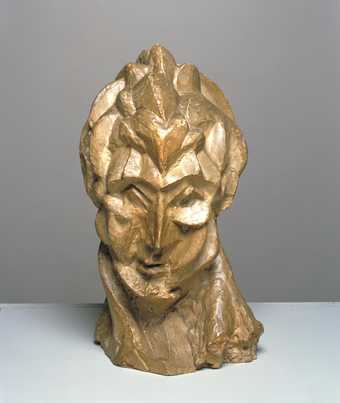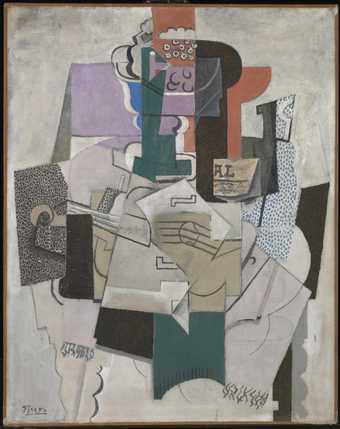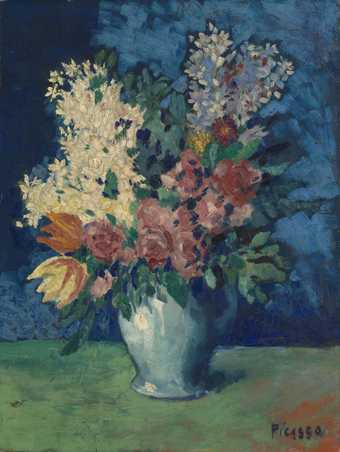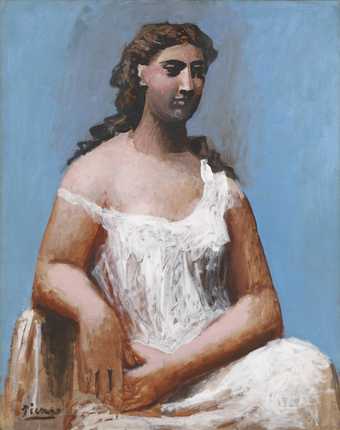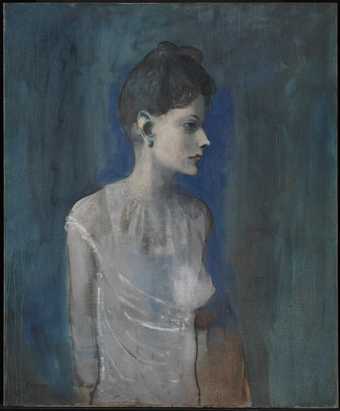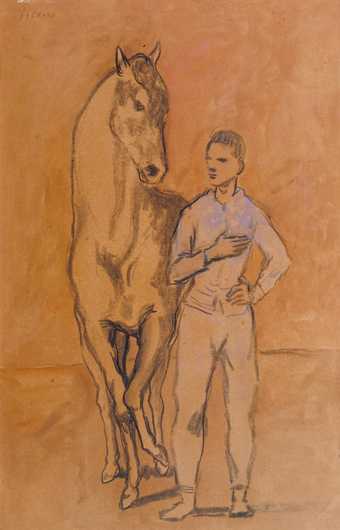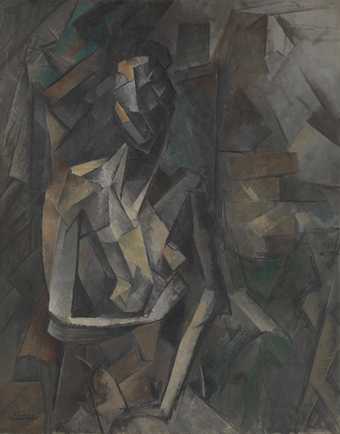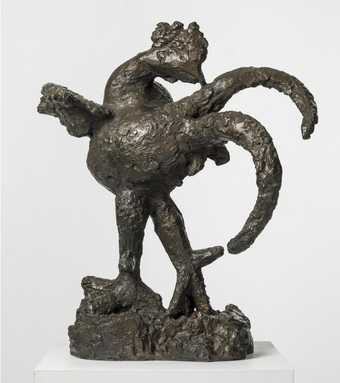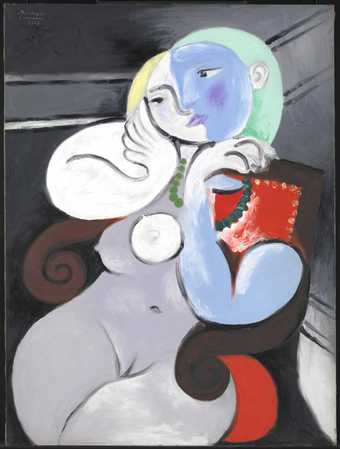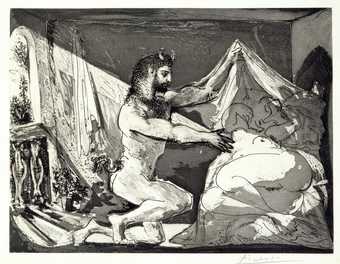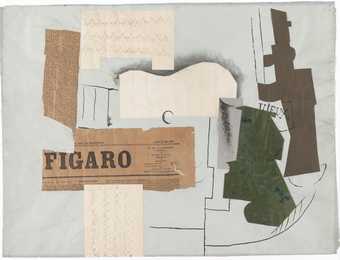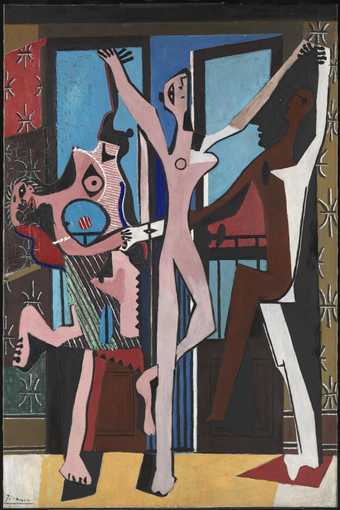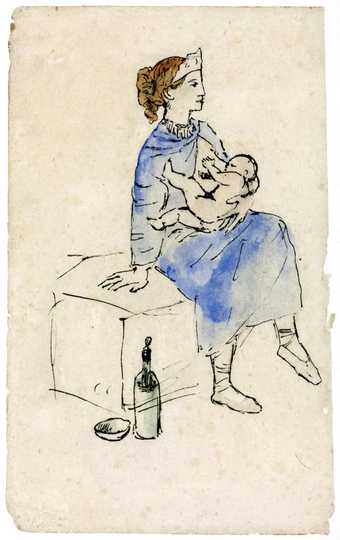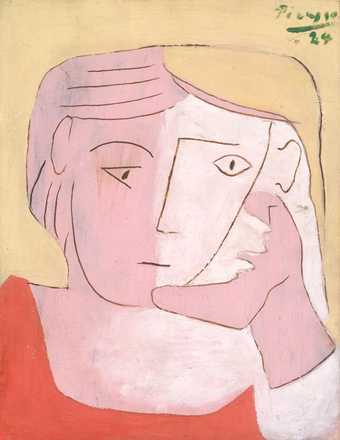
Not on display
- Artist
- Pablo Picasso 1881–1973
- Original title
- Nature morte
- Medium
- Painted wood and upholstery fringe
- Dimensions
- Object: 254 × 457 × 92 mm
- Collection
- Tate
- Acquisition
- Purchased 1969
- Reference
- T01136
Display caption
Picasso’s relief constructions, which he began making in 1912–13, extended traditional still life painting into three-dimensional space. This composition is closely related to his paintings of the period: it appears to depict a table top or small sideboard, with a knife, a beer glass, two slices of sausage and a slice of cheese or pâté. This work, however, emphasises that the painting is an object in itself. The incorporation of found objects – in this case, the real upholstery fringe to represent a table - helped to establish a new freedom in the artist’s choice of materials.
Gallery label, April 2009
Does this text contain inaccurate information or language that you feel we should improve or change? We would like to hear from you.
Catalogue entry
Pablo Picasso 1881-1973
T01136 Nature Morte
(Still Life) 1914
Not inscribed
Painted wood relief with upholstery fringe, 10 x 18 x 3 5/8 (25.5 x 46 x 9)
Purchased from Sir Roland Penrose (Grant-in-Aid) 1969
Prov:
Paul Eluard, Paris; Sir Roland Penrose, London, 1938
Exh:
Exposition Surréaliste d'Objets, Galerie Charles Ratton, Paris, May 1936 (works not numbered); The Cubist Spirit in its Time, London Gallery, London, March-May 1947 (31, repr.); 40,000 Years of Modern Art, ICA, Academy Hall, London, December 1948-January 1949 (190); XXV Biennale, Venice, June-October 1950 (Room V, 37); Picasso, Musée de Lyon, Lyons, June-September 1953 (152); Collages and Objects, ICA, London, October-November 1954 (2); Picasso: 75th Anniversary Exhibition, Museum of Modern Art, New York, May-September 1957 (works not numbered, repr.); Art Institute of Chicago, October-December 1957 (works not numbered, repr.); Philadelphia Museum of Art, January-February 1958 (sculpture 11); Picasso, Tate Gallery, July-September 1960 (75, repr.); Hommage à Pablo Picasso, Grand Palais, Paris, November 1966-February 1967 (222, repr.); Picasso: Sculpture, Ceramics, Graphic Work, Tate Gallery, June-August 1967 (20, repr.); The Sculpture of Picasso, Museum of Modern Art, New York, October 1967-January 1968 (22, repr.); Picasso, Trinity College, Dublin, May-August 1969 (11, repr.); Pioneers of Modern Sculpture, Hayward Gallery, London, July-September 1973 (212, repr.); Dada and Surrealism Reviewed, Hayward Gallery, London, January-March 1978 (1.32, repr.)
Lit:
Werner Spies, Picasso Sculpture
(London 1972), No.47, pp.54, 302, repr. p.53 in colour; Three Generations of Twentieth-Century Art: The Sidney and Harriet Janis Collection of the Museum of Modern Art
(New York 1972), p.13; Ron Johnson, The Early Sculpture of Picasso 1901-1914
(New York and London 1976), pp.133-4, repr. fig.110; Pierre Daix and Joan Rosselet, Picasso. The Cubist Years 1907-1916
(London 1979), No.746, p.330 and repr.
Repr:
Roland Penrose, The Sculpture of Picasso
(New York 1967), p.62
A photograph of the Exposition Surréaliste d'Objets at the Galerie Charles Ratton, Paris, in May 1936 shows this relief hanging on the wall (repr. William S. Rubin, Dada, Surrealism and their Heritage, New York 1968, p.142). It was presumably one of three Picassos entitled 'Still Life', all of which, as no lender's name is given in the catalogue, apparently came direct from the artist. He seems to have sold or given it shortly afterwards to his friend the poet Paul Eluard, and until he gave a sheet metal and wire construction of 1912, 'Guitar', to the Museum of Modern Art, New York, in 1971, it was the only relief of this period that he had not retained in his own possession.
It would appear to have been made about the same time as the painting 'Glass, Newspaper and Bottle' signed and dated 1914 which was included in the Sidney and Harriet Janis collection presented to the Museum of Modern Art, New York; a picture which, as the Museum catalogue notes, presents various parallels 'not only in composition, with an identical "empty" left side traversed by a patterned horizontal band extending from the vessel of a stemmed glass, but also in details, such as the scalloped handle of the knife, presumably there to cut the fruit lying before the newspaper in the painting - the counterpart of the tomato in the construction. The dotted newspaper in the one is analogous to the similarly dotted slice of bread in the other'. The only major differences in composition are that the painting lacks the rounded table edge with fringe and includes a bottle on the right. However the forms in the painting are mostly treated as coloured flat planes, with very little modelling, whereas the tilted table top in the construction, and the solid objects placed upon it, are much closer to reality.
The objects standing on the table top or small sideboard, with a dado behind, appear to be a knife, a beer glass, two slices of sausage and a slice of cheese or pâté.
Published in:
Ronald Alley, Catalogue of the Tate Gallery's Collection of Modern Art other than Works by British Artists, Tate Gallery and Sotheby Parke-Bernet, London 1981, pp.596-7, reproduced p.596
Explore
- abstraction(8,615)
-
- from recognisable sources(3,634)
-
- man-made(999)
- formal qualities(12,454)
- food and drink(980)
- table cloth(51)
You might like
-
Pablo Picasso Head of a Woman (Fernande)
1909 -
Pablo Picasso Bowl of Fruit, Violin and Bottle
1914 -
Pablo Picasso Flowers
1901 -
Pablo Picasso Seated Woman in a Chemise
1923 -
Pablo Picasso Girl in a Chemise
c.1905 -
Pablo Picasso Horse with a Youth in Blue
1905–6 -
Pablo Picasso Seated Nude
1909–10 -
Pablo Picasso Bust of a Woman
1909 -
Pablo Picasso Cock
1932, cast 1952 -
Pablo Picasso Nude Woman in a Red Armchair
1932 -
Pablo Picasso Faun Revealing a Sleeping Woman (Jupiter and Antiope, after Rembrandt)
1936 -
Pablo Picasso Bottle of Vieux Marc, Glass, Guitar and Newspaper
1913 -
Pablo Picasso The Three Dancers
1925 -
Pablo Picasso Circus Artist and Child
1905 -
Pablo Picasso Head of a Woman
1924

